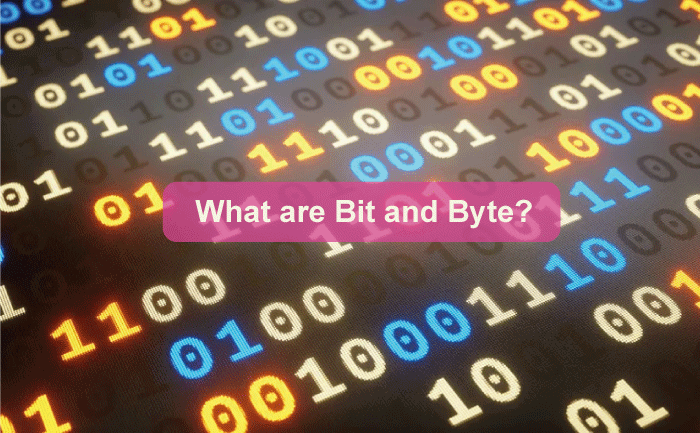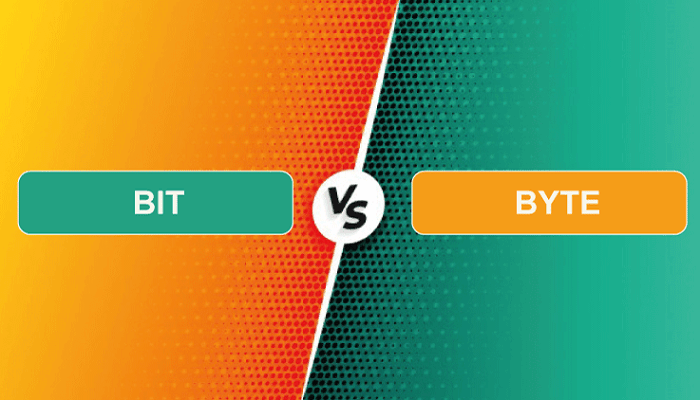Difference Between Bit and ByteUnderstanding Digital Data: The Fundamentals of Bits and BytesDigital data is ubiquitous in our modern world. From our devices to large-scale systems, digital data plays an integral role in our daily lives. At the heart of digital data are the building blocks of information: bits and bytes. This article will explore the fundamentals of bits and bytes and their importance in computing.
A bit is the smallest unit of digital data. It represents a binary digit with a value of either 0 or 1. Multiple bits represent more complex data such as characters, numbers, images, and videos. For example, the letter "A" can be represented by the 8-bit binary code 01000001. A byte, on the other hand, is a group of 8 bits. It is the basic unit of storage in most computer systems. Bytes represent larger data types, such as words, images, and files. For example, a single page of text in a document may require several kilobytes (thousands of bytes) of storage. 
Bits and bytes are important because they are the fundamental building blocks of digital data. Understanding them is crucial for anyone who works with computers, from programmers to network administrators. Storing, transmitting, and processing digital information would be impossible without bits and bytes. In addition, bits and bytes are important for measuring digital data. Data storage capacity is typically measured in units of bytes, such as kilobytes, megabytes, and gigabytes. Network bandwidth, the amount of data transmitted over a network in a given time, is also measured in bits per second or bytes per second. Bits and bytes also play a crucial role in cryptography and information security. Encryption algorithms use bits and bytes to encode and decode messages, ensuring that sensitive information remains confidential. The Difference between a Bit and a Byte: Explained
When it comes to digital data, two terms that often get used interchangeably are "bit" and "byte." While both are important in computing, they have different meanings and uses. In this article, we will explore the difference between a bit and a byte and explain why it's important to understand these distinctions.
A bit is the smallest unit of digital data. It is a binary digit with a value of either 0 or 1. The term "binary" refers to computers using a base-2 numbering system, meaning they only understand values expressed as a combination of 0s and 1s. Bits are used to represent data at the most basic level. For example, a single bit can represent the state of a light switch: 0 for off and 1 for on.
On the other hand, a byte is a larger unit of digital data consisting of 8 bits. Bytes represent larger data types, such as characters, numbers, and symbols. For example, the letter "A" is represented by the byte value 01000001 in the ASCII character encoding system. Bytes are the basic unit of storage in most computer systems. Files, documents, images, and videos are all stored in terms of bytes. When you look at the properties of a file on your computer, you'll typically see its size expressed in bytes, kilobytes, megabytes, or gigabytes.
The main difference between a bit and a byte is their size and the level of complexity they represent. A bit is the smallest unit of digital data and can only represent two possible values. On the other hand, a byte is a larger unit that consists of 8 bits and can represent a wider range of data. Bits are typically used in low-level operations such as data transmission and processing, whereas bytes are used for higher-level data types such as text and images.
Understanding the difference between a bit and a byte is important for many reasons. For one, it helps you better understand how digital data is stored and processed. It also helps you understand how data is measured, such as in file size and network bandwidth. Furthermore, understanding bits and bytes is important for anyone in computing. Programmers, network administrators, and other technology professionals must understand these concepts to perform their jobs effectively. The Anatomy of Digital Information: Bits, Bytes, and BeyondAt the core of this information are bits and bytes, but the anatomy of digital information goes far beyond these basic building blocks.
As we've already discussed, a bit is the smallest unit of digital information. It represents a binary digit with a value of either 0 or 1. A byte, on the other hand, is a group of 8 bits. Bytes represent larger data types, such as characters, numbers, and images. While bits and bytes are the fundamental building blocks of digital information, they are just the story's beginning. Digital information can be organized and manipulated in countless ways, and understanding these structures is key to understanding how digital technology works.
At a higher level, digital information is organized into data structures. These structures can take many forms, depending on the information being processed. Here are a few examples:
These data structures can be combined and manipulated in countless ways to create powerful software applications and systems.
Once digital information has been organized into a data structure, it can be transmitted and processed using various technologies. Here are a few examples:
The anatomy of digital information is complex and multifaceted. While bits and bytes are the fundamental building blocks of digital data, they are just the story's beginning. Digital information can be organized into various data structures and transmitted and processed using various technologies. Understanding these structures and technologies is key to understanding how digital technology works and how it can be used to solve real-world problems. Why Knowing the Difference Between Bits and Bytes MattersOne of the most fundamental concepts in digital technology is the difference between bits and bytes. While it may seem like a small detail, understanding these two terms' differences can greatly impact how you use and interact with technology.
One of the most important reasons to understand the difference between bits and bytes is to understand how data is stored on digital devices. For example, if you're shopping for a new hard drive or USB stick, you'll need to know the storage capacity in bytes to understand how much data you can store. Similarly, if you're trying to determine the size of a file you want to upload or download, you'll need to know the file size in bytes.
Another important reason to know the difference between bits and bytes is to avoid confusion when discussing digital technology. For example, if you're trying to explain a technical issue to a support technician, using the wrong term (bits vs. bytes) can lead to misunderstandings and miscommunication. Knowing the correct term, you can communicate more effectively and get the help you need faster.
Internet speeds are often measured in bits per second (bps), so understanding the difference between bits and bytes is important for understanding your internet speed. If you see an internet speed of 100 megabits per second (Mbps), you may think that means you can download 100 megabytes (MB) of data per second. However, since there are 8 bits in a byte, a speed of 100 Mbps means you can download 12.5 MB of data per second. Knowing the difference between bits and bytes can help you accurately interpret internet speed test results and make informed decisions about your internet service provider.
Networking and communications technologies like Wi-Fi and Bluetooth rely on understanding bits and bytes. For example, Wi-Fi routers are rated in terms of their maximum data transfer rate in Mbps, while Bluetooth devices often advertise their data transfer rate in kilobits per second (kbps). Knowing the difference between bits and bytes can help you better understand the capabilities and limitations of these technologies. Understanding the difference between bits and bytes is fundamental in digital technology. It's important to understand data storage, avoid confusion when discussing technology, interpret internet speed test results, and understand networking and communications technologies. While it may seem like a small detail, having a basic understanding of bits and bytes can greatly impact how you use and interact with technology daily. Bits vs. Bytes: Which One is More Important in Computing?Regarding computing, two fundamental units of measurement are essential to understand: bits and bytes. While both of these units are important, they have different roles to play in computing.
A bit is the smallest unit of digital information. It can have a value of either 0 or 1, and it's used to represent the binary language that computers use to communicate. A byte, on the other hand, is a group of 8 bits. Bytes represent larger information units, such as characters in text or pixels in an image.
So, which one is more important: bits or bytes? The answer is that both are important, but in different ways. Bits are important because they are the building blocks of digital communication. All digital information, from text and images to video and audio, is ultimately made up of bits. Understanding bits is essential for understanding how computers communicate, store, and transmit data. Bytes are also important because they can group bits into larger information units. For example, if you're downloading a file from the internet, the file size will be measured in bytes. If you want to know how long it will take to download the file, you need to know the file size in bytes and your internet speed in bits per second. In general, bits are more important when it comes to the technical details of computing. At the same time, bytes are more important for practical applications, such as measuring file sizes and internet speeds. Both bits and bytes are important in computing but have different roles. Bits are the building blocks of digital communication, while bytes can group bits into larger information units. Understanding these units is essential for anyone working with computers, whether you're a programmer, a network administrator, or a casual user. By understanding the difference between bits and bytes and how they are used, you can better understand how computers work and how to make the most of them in your daily life. Difference Table
ConclusionIn the digital age, understanding the difference between bits and bytes is essential for anyone working with computers. Both of these units play important roles in computing, with bits serving as the building blocks of digital communication and bytes providing a way to group bits into larger information units. By understanding the differences between these two units and their use, we can better understand how computers work and how to make the most of them in our daily lives. Whether you're a programmer, a network administrator, or a casual user, having a basic understanding of bits and bytes can help you communicate more effectively, interpret technical information more accurately, and use technology more efficiently.
Next TopicDifference between
|
 For Videos Join Our Youtube Channel: Join Now
For Videos Join Our Youtube Channel: Join Now
Feedback
- Send your Feedback to [email protected]
Help Others, Please Share










